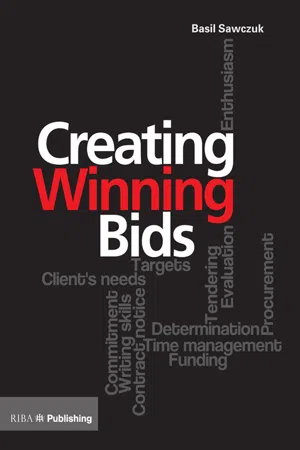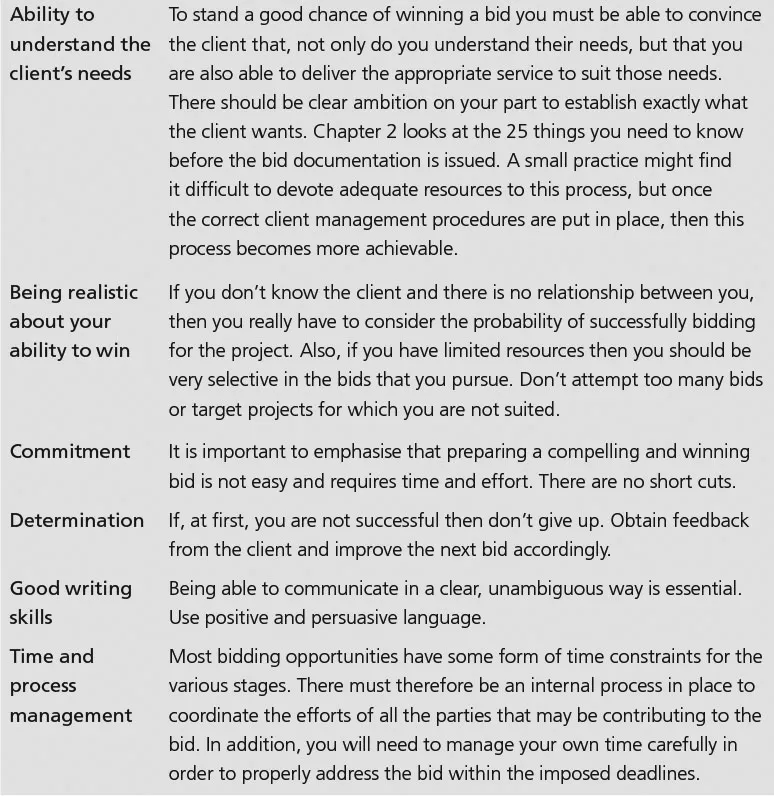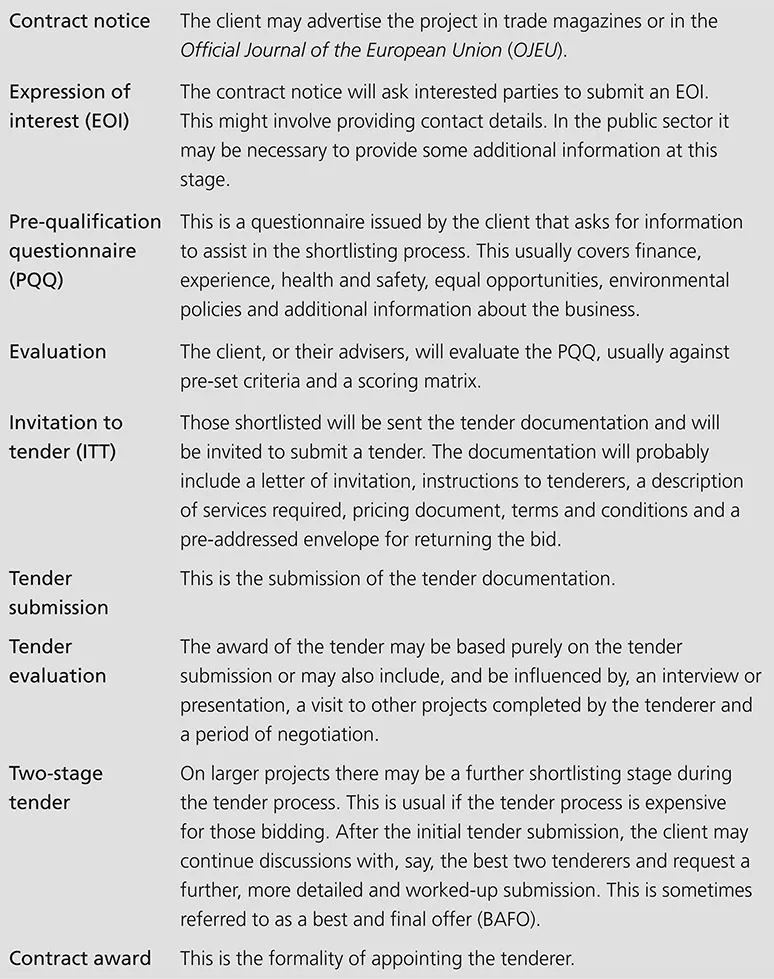
- 128 pages
- English
- ePUB (mobile friendly)
- Available on iOS & Android
Creating Winning Bids
About This Book
'Creating Winning Bids' sets out the key stages in the production of a winning bid. Based on tried and tested methods, and using a simple step-by-step process, it will improve your chances of success in what can otherwise seem a daunting and complex process. Distilling the author's experience of over 25 years of bidding in the public and private sectors, it is packed with practical tips about what your client really wants to see. Beginning with a concise look at how to find new opportunities for work, it examines the various types of bid that can be made and includes invaluable explanations of the jargon used in the bidding process – from OJEU to PQQs.
Illustrated throughout with useful diagrams and checklists, and covering a range of procurement routes, this guide will help anyone from the sole practitioner to the large firm with a dedicated bidding team to create practical and perfectly-tailored winning bids.
Frequently asked questions
Information
Chapter 1
Finding opportunities to bid for work
Not so daunting
Bidding to win work
- reduce the risk of making the wrong choice
- satisfy shareholders (or the public if the work is in the public sector) that the selection process was fair
- achieve value for money
- select a consultant whose ethos matches their culture
- ensure that the consultants are financially stable, have sufficient resources, appropriate experience and the necessary systems and technology in place to suit the demands of the project
- obtain input from the consultants at an early stage.


Understanding the bidding process

Types of bid
Negotiated contract
- Take the time and effort to submit a good proposal, ensuring that your suitability for the project is beyond question – don’t give the client a reason to seek an alternative proposal.
- Refresh your existing relationship – don’t let the client think that you are taking the relationship for granted. Deal with your existing client as if they were a new client that you are trying to convince to appoint you.
- Enhance your service offering – your client might have been approached by your competitors and they may be offering better value for money.
- Obtain feedback whenever you can – emphasise the good points in your proposals or bid and demonstrate how you have addressed any shortcomings.
Bidding direct to the client
Single project
| Restricted tender process | The consultant (service provider) will have to respond to an advertisement expressing an interest in tendering. They will then have to complete a PQQ to demonstrate that they have sufficient experience and resources to meet the client’s needs. Only those who are subsequently shortlisted and invited may submit a tender. |
| Open tender process | This differs from the restricted tender process in that all those who request the tender documentation will be invited to submit a tender. There is no shortlisting with a PQQ stage. Instead, the information that is normally requested in the PQQ is requested as part of the tender. This procedure is often used if the timetable does not permit the separate PQQ stage or the marketplace is limited and the client wishes to stimulate extra interest. |
| Negotiated tender process | This uses a PQQ stage but allows the client to negotiate the contract terms within strict guidelines. This process is rarely used and is usually confined to exceptional circumstances, such as when a rapid response is required in emergencies or where a particular company is the sole provider of supply, or relevant experience or capability. |
- targeting the private sector where the process may be simpler and involve less red tape
- that there may be an opportunity to negotiate without the need for competitive bids in the private sector, which is rarely the case in the public sector
- targeting the low-value projects within the public sector where there may be limited competition from larger competitors. Equally, if you are a larger consultancy then perhaps you would not be able to compete on price against the smaller competitors who may be targeting the lower value work.
Framework contracts

- offers the client reduced fee values due to the promise of a given volume of work
- gives the cons...
Table of contents
- Cover
- Title
- Copyright
- Contents
- Dedication
- About the author
- CHAPTER 1 FINDING OPPORTUNITIES TO BID FOR WORK
- CHAPTER 2 WHAT TO ESTABLISH BEFORE TENDER OR PRE-QUALIFICATION RELEASE
- CHAPTER 3 CREDIBILITY, CAPABILITY, COMPATIBILITY AND RELIABILITY (THE 3Cs + R TEST)
- CHAPTER 4 IMPROVING YOUR CHANCES OF SUCCESS THROUGH BETTER UNDERSTANDING OF YOUR COMPETITORS
- CHAPTER 5 PREPARATION AND PLANNING THE PROCESS
- CHAPTER 6 CREATING THE DOCUMENT
- CHAPTER 7 USING APPENDICES
- CHAPTER 8 SHOWING OFF PAST PROJECTS
- CHAPTER 9 OTHER CONSIDERATIONS
- INDEX